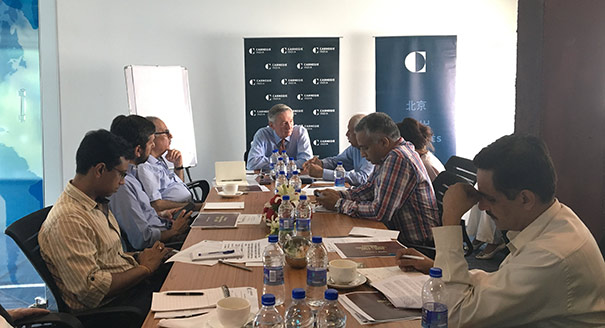Registration
You will receive an email confirming your registration.
Chinese military expenditure has gradually risen over the years along with its economy, but recently Beijing’s defense budget has intensified to include weapons and methods of strategic warfare. This development has tremendous implications for the capabilities and readiness of the People’s Liberation Army (PLA).
Carnegie India hosted (Retd.) Lieutenant Colonel Dennis J. Blasko of the U.S. army to discuss these developments in China’s military reforms. The discussion was moderated by Mr. Jayadeva Ranade, member of the National Security Advisory Board and president of the recently established Centre for China Analysis and Strategy.
Discussion Highlights
- Military Modernization Program: Participants argued that Chinese military reform programs are evolutionary and multi-generational. They said that the goals of the new military force are focused on dealing with effective combat skills, deterrence, and military operations other than war. Participants discussed the timeframe of the modernization program, which they said would span three decades. They cited statements from President Xi Jinping asserting that the military is currently in its the second stage of the modernization process. The goal of the modernization of China’s army, according to the participants, is not only to project power internationally, but also to maintain peace and stability within the country.
- Changes in Operational Units: Participants said that in the past two years, the PLA has undergone a vast number of changes, such as the reduction of troops, reassignment of commands, and introduction of new departments. They argued that prominent changes were made with the intention of increasing the number of brigades, new types of combat units, special operation forces, and aircraft systems. These, they said, were undertaken, among other reasons, to contribute to peacekeeping and humanitarian efforts on international territories. Participants added that China’s naval budget is a relatively new development. This move, they explained, is aimed at fulfilling China’s aim to transform its large land-based army to include a strong maritime military force.
- Anti-Corruption Campaign: Participants said that President Xi Jinping’s anti-corruption campaign is also directed toward the army. This focus, they said, was targeted on senior officials, not the lower echelons of the PLA. Participants stated that the anti-corruption campaign in the military was a measure to address the financial gaps that obstruct modernization efforts. They added that since the anti-corruption campaign, the PLA has been able to allocate funds in training all officers— regardless of their position—in modern warfare.
- Extensive Recruitment: Participants said that although the Chinese military is still technically based on conscription, the PLA mainly attracts volunteers. However, they stated that in the last few years, the military has been actively recruiting from all sections of Chinese society, including college graduates from its urban centers. To do this, the participants discussed that the government has begun offering basic incentives, such as subsidized higher education.
- Annual Training Program: Participants argued that as China’s military capabilities transform, due to efforts in modernization and the incorporation of strategic warfare, the PLA recognized that personnel training needs to be matched. Therefore, they stated, the PLA conducts an annual, planned, progressive training schedule for all branches in the military.
This event summary was prepared by Rhea Menon, an intern at Carnegie India.
